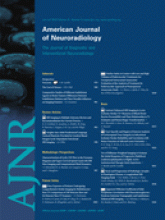Abstract
BACKGROUND AND PURPOSE: The cisternal segment of the trochlear nerve is difficult to identify reliably by routine MR imaging. We investigated the visibility and anatomic features of the trochlear nerve by using high-resolution 3D-bTFE imaging in healthy subjects.
MATERIALS AND METHODS: This study was conducted with 32 healthy subjects without ocular movement disorders. For us to visualize the cisternal segment of the trochlear nerve, all subjects underwent 3D-bTFE imaging at 3T with 2 different resolutions: conventional resolution (voxel size, 0.67 × 0.45 × 1.4 mm) and high resolution (voxel size, 0.3 × 0.3 × 0.25 mm). Visibility of the trochlear nerve was graded with the use of a qualitative scale of certainty as follows: definite, probable, and indeterminate. The diameter of the trochlear nerve was measured.
RESULTS: On conventional-resolution images, the visibility of the trochlear nerve was definite in 3 nerves, probable in 12 nerves, and indeterminate in 49 nerves. On high-resolution images, visibility was definite in 63 nerves and probable in 1 nerve. The mean diameter of the trochlear nerve was 0.54 mm (range, 0.35–0.96 mm).
CONCLUSIONS: The trochlear nerve was visualized 100% of the time on high-resolution imaging with a voxel smaller than the nerve diameter. High-resolution imaging should have an important role in investigating the pathogenic mechanism of neuropathic strabismus, such as congenital superior oblique palsy.
Abbreviations
- 3D-bTFE
- 3D balanced turbo-field echo
- NA
- not applicable
- SENSE
- sensitivity-encoding
- SNR
- signal-to-noise ratio
- Copyright © American Society of Neuroradiology












